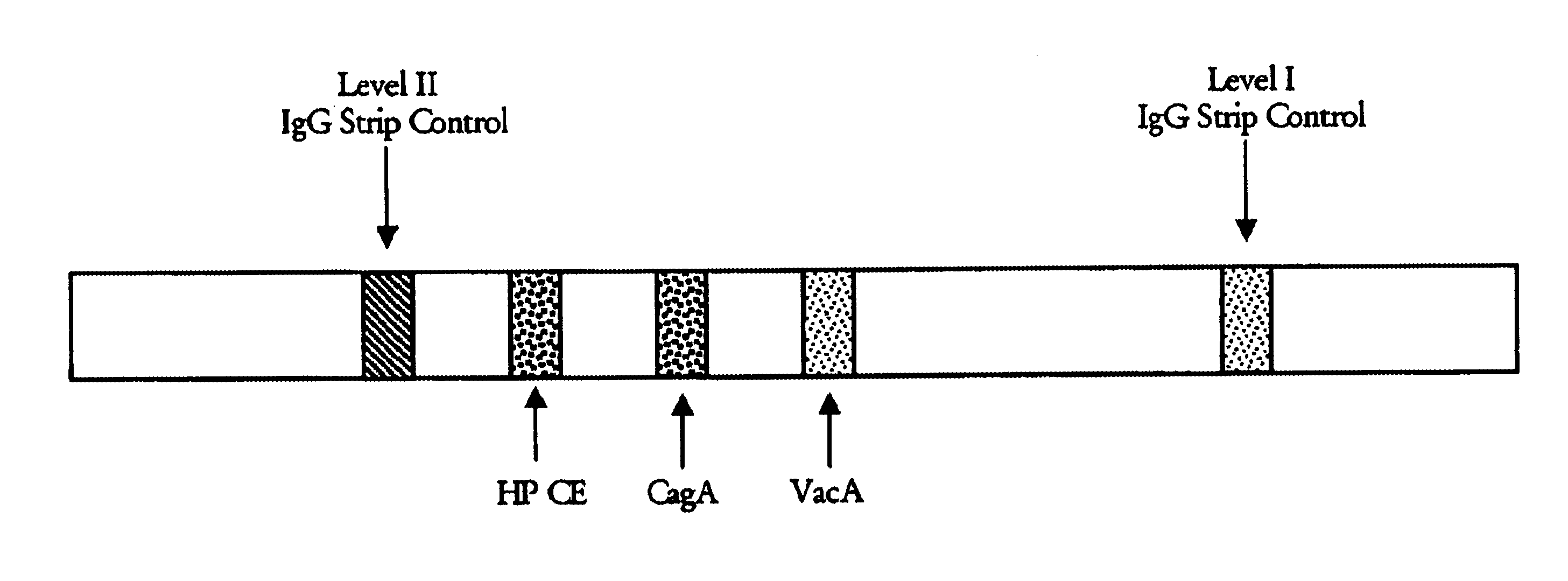Helicobacter pylori diagnostics
a technology of helicobacter and pylori, applied in the field of bacterial diagnostic techniques, can solve the problems of time-consuming assay, inconvenient use, and inability to detect peptic ulcers and/or gastric adenocarcinomas, and achieve the effect of simple, extremely accurate and efficient method for diagnosing h
- Summary
- Abstract
- Description
- Claims
- Application Information
AI Technical Summary
Benefits of technology
Problems solved by technology
Method used
Image
Examples
example 1
Production of an H. pylori VacA Polypeptide
[0106]A VacA polypeptide was produced recombinantly as a fusion protein of 71.2 kDa which included 154 amino acids of human superoxide dismutase (SOD) (Hallewell et al., Nucl. Acids Res. (1985) 13:2017-2134), a linker of five amino acids (Asn-Leu-Gly-Ile-Leu) and the VacA amino acid sequence Gly-311 through Ile-819 of H. pylori CCUG17874 (Covacci et al., Proc. Natl. Acad. Sci. USA (1993) 90:5791-5795; Telford et al., J. Exp. Med. (1994) 179:1653-1658).
[0107]In particular, DNA encoding for the truncated VacA protein was synthesized by PCR and fused in frame with DNA sequences coding for SOD. The glucose regulated ADH2 / GAPDH promoter (Cousens et al., Gene (1984) 61:265-275) was then incorporated at the 5′-end of the amplified fragment and the resulting cassette was cloned into the yeast expression vector pBS24.1 (Pichuantes et al., Protein Eng., Principle and Prac. (1996) 5:129-161). This vector contains 2μ and inverted repeat (IR) sequences ...
example 2
Production of an H. pylori CagA Polypeptide
[0109]A CagA polypeptide of 268 amino acids and having a molecular weight of 29.2 kDa, including amino acids Glu-748 through Glu-1015 of the CagA protein of the Chilean strain of Helicobacter pylori, Chetx-1, was produced recombinantly as follows. The DNA coding for this truncated CagA protein was synthesized by PCR and the initiation codon ATG was introduced at the 5′-end of the amplified fragment. The ADH2 / GAPDH hybrid promoter (Cousens et al., Gene (1984) 61:265-275) was then incorporated at the 5′-end of the PCR-synthesized fragment and the resulting cassette was cloned into the yeast expression vector pBS24.1, essentially as described above. The resulting recombinant plasmid was used to transform Saccharomyces cerevisiae AD3 (Mat a, leu2, ura3-52, prb1-1122, pep4-3, prcl-407, ::pDM15 (G418R), LEU2(ΔAD), [CIR0]) and expression of the recombinant antigen was monitored by Coomassie blue staining and immunoblot analysis of yeast proteins f...
example 3
H. pylori Strip Immunoblot Assay (SIA) Using Type-Specific and Type-Common H. pylori Antigens
[0111]A. An SIA was done as follows. An H. pylori extract containing a mixture of antigens including type-common antigens was obtained from Bioseed, Inc., Hillsborough, Calif. Briefly, the extract was prepared from an H. pylori bacterium obtained from the American Type Culture Collection (ATCC) having an ATCC strain designation of ATCC 43504. The extract was prepared using detergent extraction and sonication.
[0112]The VacA and CagA type-specific antigens, described in Examples 1 and 2, respectively, were applied in discrete bands to nitrocellulose strips at concentrations of 1-2 μg / ml. The lysate including the type-common antigens was coated as another discrete band at a concentration of 0.5-1 μg / ml onto the same nitrocellulose strips. As internal controls, additional bands contained purified human IgG at a low (100-185 ng / ml) and high (500-925 ng / ml) concentration. Other strips were coated ...
PUM
| Property | Measurement | Unit |
|---|---|---|
| Fraction | aaaaa | aaaaa |
| Fraction | aaaaa | aaaaa |
| Fraction | aaaaa | aaaaa |
Abstract
Description
Claims
Application Information
 Login to View More
Login to View More - R&D
- Intellectual Property
- Life Sciences
- Materials
- Tech Scout
- Unparalleled Data Quality
- Higher Quality Content
- 60% Fewer Hallucinations
Browse by: Latest US Patents, China's latest patents, Technical Efficacy Thesaurus, Application Domain, Technology Topic, Popular Technical Reports.
© 2025 PatSnap. All rights reserved.Legal|Privacy policy|Modern Slavery Act Transparency Statement|Sitemap|About US| Contact US: help@patsnap.com



